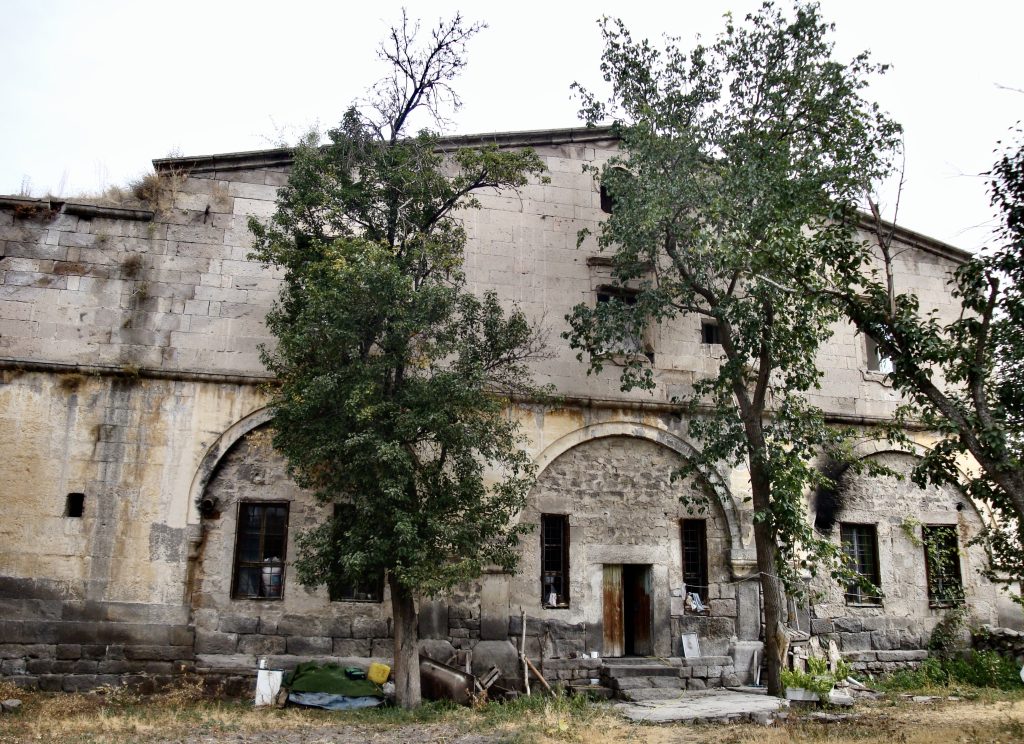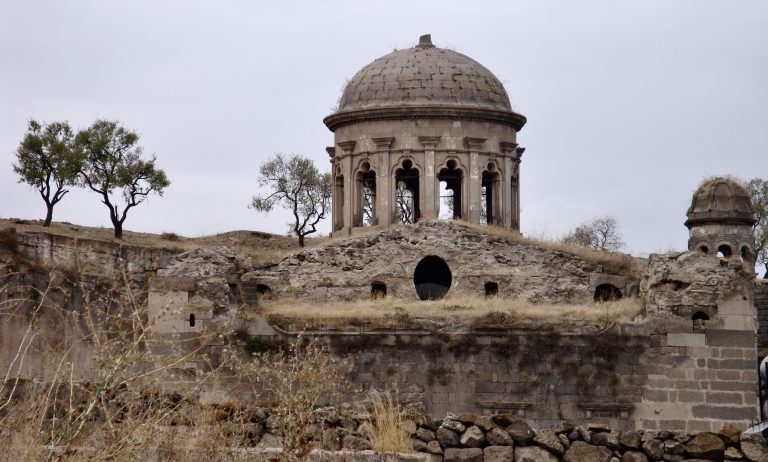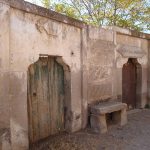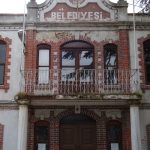Time was when Kayseri was not a place one actively wanted to visit. The streets were dark, the pavements uneven and after 9pm a woman alone was likely to find herself attracting attention of the wholly unwanted kind, leading to self-imposed curfews in hotel rooms that were lacking in comforts of the boutique variety. Ten years down the line I can still hardly believe how much things have changed. There’s the flashy new otogar with its shades of the Temple at Luxor support columns. There’s the flashy new football stadium. And there’s the flashy new tram whose shiny red cars convey passengers smoothly and soundlessly about the town centre.
But the change goes much deeper than these big-ticket projects. Sitting in a bus heading north along Sivas Caddesi (so long nowadays that it morphs eventually into the posher-sounding Sivas Bulvarı) I admired the lovely parks laid out alongside the roads, the newly inaugurated bike hire scheme, the children’s play areas in which swings are suspended from the biceps of outsize statues of Popeye. The newly landscaped Cumhuriyet Meydanı in front of the old city’s basalt walls is the very model of modern town planning, with pavement cafes lined up to catch commuters on their way home and even the tourist information office conveniently housed right where visitors will be able to find it most easily. The new Forum Shopping Centre is shaping up to compete with the one in İstanbul in size and splendour. No doubt some of this is a nod of recognition towards Kayseri as the birthplace of Turkey’s current president, Abdullah Gül, but at the same time it matches what has happened in Konya, Gaziantep and many other towns of the Anatolian heartlands. But on this particular trip I’m not that interested in Kayseri itself. Instead I have my sights set on visiting Germir, a suburb whose name I’ve had scribbled on a piece of paper since an antique dealer first mentioned it to me some ten years ago.
After the confusion surrounding a bus ride to Ağırnas I wasn’t taking any chances this time. “I want the old Germir,” I said to the bus driver. “I’m looking for the old houses.”
The driver waved his hand airily towards a long stone-built wall paralleling the road. “This is it,” he said vaguely just as my eyes alighted, on the other side of the road, on the impressive dome of a 19th-century church. Technically Germir is just a suburb of Kayseri but it would be hard to imagine anywhere further away from the glitz and modernity of the city centre. As I strolled uphill towards the dome I passed the fallen arches of what must once have been a han. In the orchard behind it a woman was herding a flock of sheep past the trees while her children played amid the ruins, oblivious to the accumulating rubbish.
Round the corner I came upon the church, huge and abandoned. Astounded, I gazed at the elaborate detached bell-tower and at the delicate tracery of the windows encircling the dome, a dead ringer for that of a Romeo and Juliet balcony spotted just days ago in nearby Talas. As in Talas and İncesu the church had been built into the embrace of the valley wall, in this case rather oddly with the narthex and entrance actually facing it. At first I could see no way in, could catch just fleeting, tantalising glimpses of painted capitals through the lofty windows. Then to the far side an open grille let me scramble inside.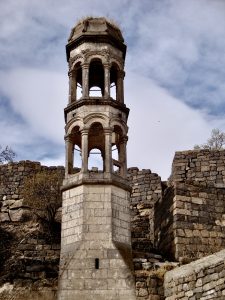
The church was derelict and graffiti-covered, the floor uneven, the odd hole suggesting that treasure hunters had been at work. Of the many images of saints with which it must once have been adorned, only a couple now survived, but I was still able to mount the stairs to the western gallery and gaze out over the vast, empty nave. Not for the first time I pondered the cruelty of fate. This church would have been built in the late 19th century, at a time when the restrictions on what the minority populations could do with their places of worship had been lifted and when money was flooding back to Central Anatolia from İstanbul where many locals had made new and more prosperous lives for themselves. How secure their lives must have seemed at that moment. How could they have known that within fifty years it would all be over, that the Greeks of Anatolia would have been forced to swap places with the Turks of Greece, that those Armenians who escaped with their lives would have been driven out of the country.
That church must have belonged to the Rums, the Greek Orthodox community, but when I wandered a little deeper into what was effectively a self-contained village I soon found another church, more austere in its design, whose origins puzzled me more. The plaster on the outside wall had started to fall away exposing sections of elaborately carved stonework. None of the carvings looked like the frilly crosses that usually adorn Armenian churches but still I wondered. Two men were sitting on a balcony by the roadside. “Do you know anything about this church?” I asked them. “Do you know who it used to belong to?”
The men looked uncomfortable in the way of people who realise that they’ve never given the matter a second’s thought and now here’s this pesky foreigner expecting them to have the answer at their fingertips. “Rum herhalde (probably Greek),” one of them said, but he didn’t look very happy with his answer and his friend cut in to assure me that the church I’d already visited was definitely Rum as, he believed, was another one a little further along the road.
Thanking them, I pressed on round the corner, pausing to pass the time of day with a woman bent double beneath the weight of a sack of dried dung which she was storing in what looked like a block of abandoned shops ready to be used as fuel for the winter. Then I rounded another corner and found myself in a square centred on a well and lined with fine stone houses. It reminded me of Chipping Campden in the Cotswolds, but a Chipping Campden not of antique shops and blazing fires in warm and welcoming country hostelries but a forgotten Chipping Campden of dereliction and despair, a Chipping Campden that no one had envisaged becoming a hub for tourism, a place where only the wealthy could afford to live. Backing onto the square was the third church that the two men had mentioned. Ducking down a side street, I found the north wall caved in to expose a fenced-off garden in the nave in which amid the dahlias sat a couple who had apparently set up home in the south aisle. Through the open door of a chapel that must once have opened off the north aisle I glimpsed the horns and burly head of a bull sitting comfortably on the floor; creeping forward, I saw his spouse eyeing me warily from the other side of the chamber.
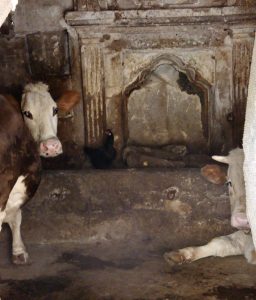 It was just about possible to make out the apse of the church with a pattern painted around its beam. This was still seemingly intact although a corrugated iron roof tacked over the south aisle suggested that that was in more perilous condition. I was thrown into a quandary. I was dying to talk to the couple in the garden but was there an etiquette to be observed here? Was this the sort of subject that was not raised in polite society rather like the new wart sprouting on a well-loved aunty’s nose? – that here were Muslims living inside a church?
It was just about possible to make out the apse of the church with a pattern painted around its beam. This was still seemingly intact although a corrugated iron roof tacked over the south aisle suggested that that was in more perilous condition. I was thrown into a quandary. I was dying to talk to the couple in the garden but was there an etiquette to be observed here? Was this the sort of subject that was not raised in polite society rather like the new wart sprouting on a well-loved aunty’s nose? – that here were Muslims living inside a church?
Backtracking hastily, I found several villagers parked on benches on the main road. A man stood up to greet me. “There are people living in that church,” I stuttered.
“Yes, I do! Would you like to take a look?” he said, and at once we were heading back and he was fetching the key and leading me upstairs to the rooms above what must once have been a stupendously large narthex. “Three of us live here,” he said steering me past the kitchen and bedroom and into a spacious living room. “Doesn’t it get cold?” I asked, eyeing the stone floor uncomfortably. ”
No! We have a stove.”
Downstairs, someone else had set up kitchen in the actual narthex, an enormous, high-ceilinged room full of clutter, with boxes, bags, plastic containers and a ripe smell of fruit and vegetables. To the side was a flagstoned sitting room ringed with a sedir like any traditional village home. It was, frankly, a bigger living space than that available to many of my Göreme neighbours, and given the money to do it up properly it could actually have been very Homes and Gardens in its attraction. Then Mehmet Bey threw open the back door and we walked down a couple of steps into an enormous garden gone comprehensively to seed. I stared up at the building we had been exploring. It was completely intact. How could its architect ever have envisaged the fate that would befall it?
Gushing thanks, I left Mehmet in the square and pressed on along a narrow road closely pressed on either side by stone houses, the occupants of whose upper storeys would only have had to open the windows to be able to chat quite comfortably to the neighbour across the way. A large truck piled high with sacks of potatoes was blocking the way which left me time enough to notice a piece of old marble purloined from an archaeological site patching up a hole in someone’s brickwork. Then I ambled through the arch created beneath one of the houses and emerged in a back street of glorious houses still with their pretty wooden shutters and their fine metal door fittings intact. At the end of the street villagers were drinking tea round a well shaded by a vine. Pats of dung were piled up across the way. Above them on the horizon the high-rise apartment blocks of Kayseri proper loomed up, so physically near and yet so aesthetically distant.
As I waited for the bus to run me back to modernity, a passing boy handed me a slice of apple. In the road a mangy dog scratched its wretched skin. In the ditch behind me rubbish piled up unheeded.
Written: 9 October 2011
